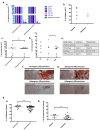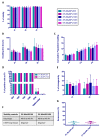Scale-Up of Academic Mesenchymal Stromal Cell Production
- PMID: 37445448
- PMCID: PMC10342966
- DOI: 10.3390/jcm12134414
Scale-Up of Academic Mesenchymal Stromal Cell Production
Abstract
Background: Many clinical trials have reported the use of mesenchymal stromal cells (MSCs) following the indication of severe SARS-CoV-2 infection. However, in the COVID19 pandemic context, academic laboratories had to adapt a production process to obtain MSCs in a very short time. Production processes, especially freezing/thawing cycles, or culture medium have impacts on MSC properties. We evaluated the impact of an intermediate cryopreservation state during MSC culture to increase production yields.
Methods: Seven Wharton's jelly (WJ)-MSC batches generated from seven different umbilical cords with only one cryopreservation step and 13 WJ-MSC batches produced with intermediate freezing were formed according to good manufacturing practices. The identity (phenotype and clonogenic capacities), safety (karyotype, telomerase activity, sterility, and donor qualification), and functionality (viability, mixed lymphocyte reaction) were analyzed.
Results: No significant differences between MSC production processes were observed, except for the clonogenic capacity, which was decreased, although it always remained above our specifications.
Conclusions: Intermediate cryopreservation allows an increase in the production yield and has little impact on the basic characteristics of MSCs.
Keywords: Wharton’s jelly; mesenchymal stem cells; scale-up.
Conflict of interest statement
The authors declare no conflict of interest.
Figures




References
-
- Thompson M., Mei S.H.J., Wolfe D., Champagne J., Fergusson D., Stewart D.J., Sullivan K.J., Doxtator E., Lalu M., English S.W., et al. Cell Therapy with Intravascular Administration of Mesenchymal Stromal Cells Continues to Appear Safe: An Updated Systematic Review and Meta-Analysis. EClinicalMedicine. 2020;19:100249. doi: 10.1016/j.eclinm.2019.100249. - DOI - PMC - PubMed
-
- Laroye C., Lemarié J., Boufenzer A., Labroca P., Cunat L., Alauzet C., Groubatch F., Cailac C., Jolly L., Bensoussan D., et al. Clinical-Grade Mesenchymal Stem Cells Derived from Umbilical Cord Improve Septic Shock in Pigs. Intensive Care Med. Exp. 2018;6:24. doi: 10.1186/s40635-018-0194-1. - DOI - PMC - PubMed
-
- Condor J.M., Rodrigues C.E., Sousa Moreira R.d., Canale D., Volpini R.A., Shimizu M.H.M., Camara N.O.S., Noronha I.D.L., Andrade L. Treatment with Human Whartons Jelly-Derived Mesenchymal Stem Cells Attenuates Sepsis-Induced Kidney Injury, Liver Injury, and Endothelial Dysfunction. Stem Cells Transl. Med. 2016;5:1048–1057. doi: 10.5966/sctm.2015-0138. - DOI - PMC - PubMed
-
- Chen J., Hu C., Chen L., Tang L., Zhu Y., Xu X., Chen L., Gao H., Lu X., Yu L., et al. Clinical Study of Mesenchymal Stem Cell Treatment for Acute Respiratory Distress Syndrome Induced by Epidemic Influenza A (H7N9) Infection: A Hint for COVID-19 Treatment. Engineering. 2020;6:1153–1161. doi: 10.1016/j.eng.2020.02.006. - DOI - PMC - PubMed
LinkOut - more resources
Full Text Sources
Miscellaneous

